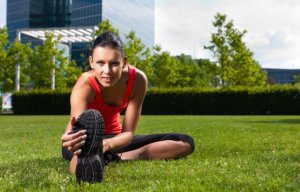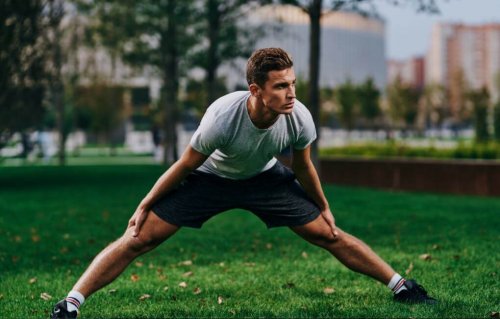Warm-Up Dos and Don'ts

It’s very important to complete a warm-up before performing any kind of exercise. Warming up will help reduce the risk of injury while working out. The purpose of a warm-up is to raise the body temperature and prepare muscles and joints for the exertion we are about to make during our training sessions.
You might also like: Six Pieces of Advice to Stop you Quitting the Gym
The first part is static. We can start by rotating the neck, then the arms, then the hips. Then, we will touch our toes, stretch our quadriceps, do a side lunge, rotate our knees and stretch our calf muscles. This way, we will have a routine that involves the entire body.
The second part is more dynamic. You can do exercises such as touching your elbow to your knee, opening and closing your legs at the same time as you jump, and doing jumping lunges.

Warm-up dos
- The warm-up should last about 20 minutes, but this varies according to age, physical condition, and frequency of exercise.
- As we said before, we recommend that you start with simple static stretches. Once you’ve finished those, increase the intensity a little.
- On the other hand, it’s important that although you have completed a general warm-up of the muscle groups, you should take your time with the individual muscles you’ll be working on. Depending on the sport you’re playing or the type of work out you’re doing.
- Stretch the muscles that give you flexibility. This is very important so they are prepared to protect your bones and prevent a break if you fall.
- The warm-up we have mentioned is a way of increasing body temperature, so make sure it’s intense and maintain a good rhythm so you end up sweating. This is a good sign that you are doing a warm-up correctly.
- It’s just as important for your mind to be prepared as it is for your body. So, use your warm-up time to think about your objectives and prepare your mind for achieving your goals faster.

You might also like: Stretching Before Workouts: a Gym Routine Essential
Points to remember
Once you have finished your warm-up, you can start your exercise routine. When you finish, you should keep in mind that’s important to stretch again, just as much or more than you stretched prior to working out. You can dedicate about ten minutes to stretching and that should be enough.
In this case, we are trying to ensure that the muscles are sufficiently stretched and warm before exercising. This will help prevent contraction due to the absence of muscular tension after you end your workout.
Some exercises we can do after our workout to stretch the muscles include stretching our back, quadriceps, calves, and hamstrings.
Don’t forget to place more emphasis on stretching the muscles that did the most work during your exercise or sports session.
Warm-up don’ts
- A general rule for a warm-up is that you should not feel any pain. This also applies to your pre-workout stretching. What we are trying to do is prepare the muscle for exercise or stretch it in order to have an easier recovery afterward. Therefore, we don’t want to do anything to the contrary and possibly end up injuring ourselves.
- Don’t go overboard with the intensity or duration of your warm-up. The purpose of a warm-up is to increase your body temperature and prepare you for your workout, not to leave you too tired to start your exercise session.
- For this reason, before starting your workout don’t forget to do a warm-up. However important it is to do the warm-up, it’s just as important to do it correctly. Follow the guidelines we have suggested for you, and we are confident that you will know how to do a warm-up.
It’s very important to complete a warm-up before performing any kind of exercise. Warming up will help reduce the risk of injury while working out. The purpose of a warm-up is to raise the body temperature and prepare muscles and joints for the exertion we are about to make during our training sessions.
You might also like: Six Pieces of Advice to Stop you Quitting the Gym
The first part is static. We can start by rotating the neck, then the arms, then the hips. Then, we will touch our toes, stretch our quadriceps, do a side lunge, rotate our knees and stretch our calf muscles. This way, we will have a routine that involves the entire body.
The second part is more dynamic. You can do exercises such as touching your elbow to your knee, opening and closing your legs at the same time as you jump, and doing jumping lunges.

Warm-up dos
- The warm-up should last about 20 minutes, but this varies according to age, physical condition, and frequency of exercise.
- As we said before, we recommend that you start with simple static stretches. Once you’ve finished those, increase the intensity a little.
- On the other hand, it’s important that although you have completed a general warm-up of the muscle groups, you should take your time with the individual muscles you’ll be working on. Depending on the sport you’re playing or the type of work out you’re doing.
- Stretch the muscles that give you flexibility. This is very important so they are prepared to protect your bones and prevent a break if you fall.
- The warm-up we have mentioned is a way of increasing body temperature, so make sure it’s intense and maintain a good rhythm so you end up sweating. This is a good sign that you are doing a warm-up correctly.
- It’s just as important for your mind to be prepared as it is for your body. So, use your warm-up time to think about your objectives and prepare your mind for achieving your goals faster.

You might also like: Stretching Before Workouts: a Gym Routine Essential
Points to remember
Once you have finished your warm-up, you can start your exercise routine. When you finish, you should keep in mind that’s important to stretch again, just as much or more than you stretched prior to working out. You can dedicate about ten minutes to stretching and that should be enough.
In this case, we are trying to ensure that the muscles are sufficiently stretched and warm before exercising. This will help prevent contraction due to the absence of muscular tension after you end your workout.
Some exercises we can do after our workout to stretch the muscles include stretching our back, quadriceps, calves, and hamstrings.
Don’t forget to place more emphasis on stretching the muscles that did the most work during your exercise or sports session.
Warm-up don’ts
- A general rule for a warm-up is that you should not feel any pain. This also applies to your pre-workout stretching. What we are trying to do is prepare the muscle for exercise or stretch it in order to have an easier recovery afterward. Therefore, we don’t want to do anything to the contrary and possibly end up injuring ourselves.
- Don’t go overboard with the intensity or duration of your warm-up. The purpose of a warm-up is to increase your body temperature and prepare you for your workout, not to leave you too tired to start your exercise session.
- For this reason, before starting your workout don’t forget to do a warm-up. However important it is to do the warm-up, it’s just as important to do it correctly. Follow the guidelines we have suggested for you, and we are confident that you will know how to do a warm-up.
All cited sources were thoroughly reviewed by our team to ensure their quality, reliability, currency, and validity. The bibliography of this article was considered reliable and of academic or scientific accuracy.
- Page P (2012). Current concepts in muscle stretching for exercise and rehabilitation. Int J Sports Phys Ther, 7(1):109-19. Disponible en: https://www.ncbi.nlm.nih.gov/pmc/articles/PMC3273886/
- Harvard Health Publishing. The importance of stretching. Disponible en: https://www.health.harvard.edu/staying-healthy/the-importance-of-stretching
- Harvard Health Publishing. Six tips for safe stretches. Disponible en: https://www.health.harvard.edu/staying-healthy/six-tips-for-safe-stretches
- Harvard Health Publishing. The ideal stretching routine. Disponible en: https://www.health.harvard.edu/staying-healthy/the-ideal-stretching-routine
- Clínica Mayo. Estiramiento: céntrate en la flexibilidad. Disponible en: https://www.mayoclinic.org/es-es/healthy-lifestyle/fitness/in-depth/stretching/art-20047931
This text is provided for informational purposes only and does not replace consultation with a professional. If in doubt, consult your specialist.








